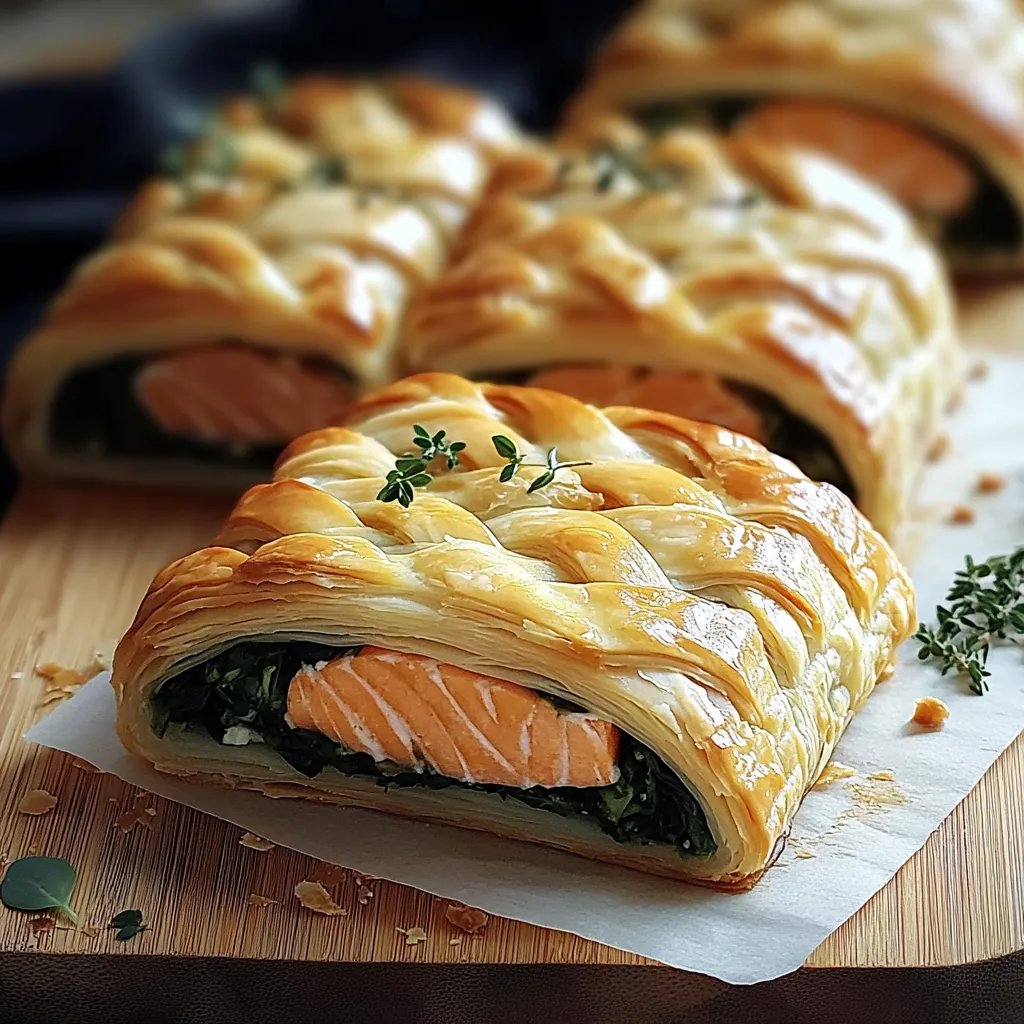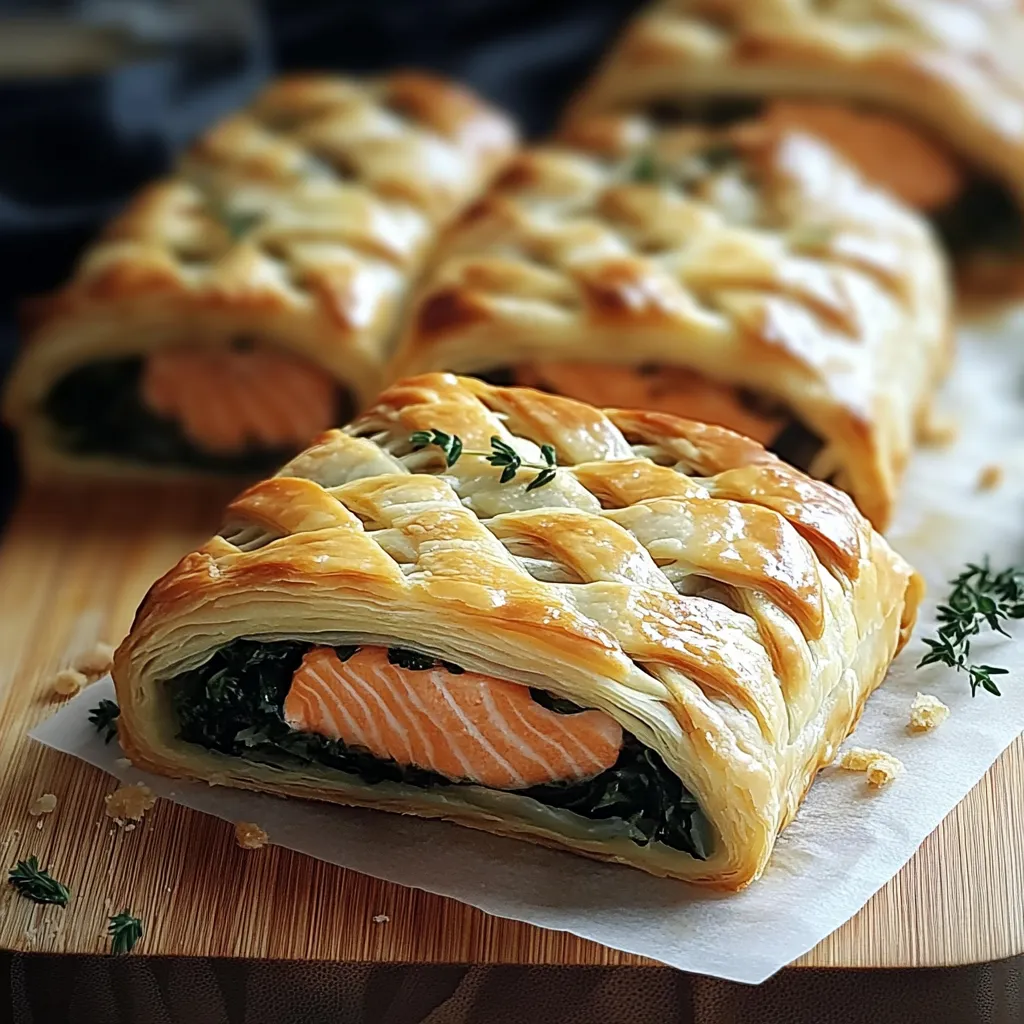 Save
Save
Tender salmon nestles within a blanket of vibrant spinach cream and golden puff pastry in this exquisite interpretation of a classic French technique. This Salmon Wellington transforms simple ingredients into an extraordinary culinary experience through the artful layering of complementary flavors and textures. Each slice reveals a stunning cross-section of coral-pink fish, emerald filling, and bronze crust—creating a dish that delights the eyes as thoroughly as it satisfies the palate, perfect for occasions that demand both elegance and substance.
I discovered this magnificent preparation during a particularly ambitious dinner party phase when I sought dishes that would impress without requiring professional culinary training. The first time I unveiled these golden parcels at the table, conversation momentarily ceased before erupting into appreciative murmurs. My typically stoic father-in-law actually raised his eyebrows in approval—high praise indeed. What began as an attempt to elevate a weeknight protein has evolved into our signature celebration dish, appearing at everything from milestone anniversaries to holiday gatherings where its dramatic presentation signals the importance of the occasion.
Elegant Essentials
- Salmon fillets: Center-cut portions ensure even cooking; wild-caught offers superior flavor
- Puff pastry: All-butter varieties provide richest flavor; proper thawing essential for good results
- Spinach: Baby varieties offer tender texture; mature leaves provide stronger flavor
- Cream cheese: Full-fat creates luxurious mouthfeel; European-style contains less water
- Shallots: Provide delicate onion flavor; brunoise dice ensures proper distribution
- Garlic: Fresh cloves deliver aromatic depth; microplane-grated ensures no harsh bits
- Fresh dill: Bright, feathery herb complements salmon perfectly; stems removed before measuring
- Lemon zest: Only the colored portion contains essential oils; avoid bitter white pith
- Dijon mustard: Smooth varieties spread most evenly; whole-grain adds textural interest
- Salt and pepper: Sea salt flakes and freshly ground pepper allow precise seasoning control
- Egg wash: Creates burnished golden exterior; ensures proper sealing of pastry edges
Culinary Creation
- Aromatic Foundation
- Begin by heating quality olive oil in a skillet over medium heat until shimmering but not smoking. Add finely diced shallots, allowing them to slowly soften and become translucent without browning. This gentle sweating process releases their sweet undertones while minimizing any harsh qualities. When nearly transparent, introduce minced garlic, stirring constantly for thirty seconds until fragrant but not colored, which would introduce bitterness. This initial aromatic layer creates the essential flavor base upon which everything builds, perfuming your kitchen with enticing anticipation.
- Verdant Filling
- Add chopped spinach to the shallot-garlic foundation, stirring frequently until the leaves wilt completely and release their moisture. Continue cooking until any liquid evaporates, which prevents soggy pastry later. Incorporate softened cream cheese in small pieces, allowing each addition to melt smoothly before adding more. The cream cheese not only provides richness but acts as a binding agent for the filling. Finish with freshly chopped dill, lemon zest, salt, and pepper, then remove from heat to cool slightly before adding the egg yolk, which enriches the mixture while helping it set during baking.
- Pastry Preparation
- Roll thawed puff pastry on a lightly floured surface to a 1/8-inch thickness, creating a rectangle large enough to generously envelop your salmon. Precision matters here—too thick and the pastry won't cook properly; too thin and it may tear or not support the filling. The pastry should feel cool but pliable. If it becomes too warm during handling, return it briefly to the refrigerator, as proper temperature ensures those magnificent buttery layers that define perfect puff pastry.
- Artistic Assembly
- Position the seasoned salmon fillet on one side of the prepared pastry, leaving adequate border for sealing. Brush the fish with a thin layer of Dijon mustard, which provides subtle tanginess that complements the rich salmon while creating a moisture barrier between fish and pastry. Spread the cooled spinach mixture evenly across the top of the salmon, creating an insulating layer that helps protect the fish from overcooking while adding vibrant flavor and color contrast that will be revealed upon slicing.
- Strategic Enrobing
- Brush the pastry edges with egg wash, then carefully fold the empty pastry half over the salmon and filling. Press the edges firmly to seal, trimming excess if necessary. This careful enclosure not only creates the distinctive Wellington appearance but serves the practical purpose of creating a perfect cooking environment for the salmon. For presentation enhancement, create decorative patterns on the pastry top using excess dough cut into leaves or other shapes, adhering with additional egg wash before completing the exterior brushing.
- Temperature Management
- Refrigerate the assembled Wellington for 30 minutes before baking—this crucial step allows the butter in the pastry to rechill completely, ensuring proper puff during baking. Meanwhile, preheat your oven thoroughly, including a baking sheet that will conduct heat directly to the bottom of the pastry, preventing the dreaded 'soggy bottom.' The hot sheet creates immediate heat contact, setting the bottom pastry layer before moisture can affect it, while the surrounding hot air works on the upper portions.
- Perfect Baking
- Place the chilled Wellington directly onto the preheated baking sheet and immediately return to the oven. Bake at 400°F until the pastry achieves a magnificent golden hue and feels crisp to the touch. The pastry functions as both cooking vessel and indicator—proper brownness signals the salmon inside has reached ideal temperature. Allow the finished Wellington to rest for 5-10 minutes before slicing with a sharp, serrated knife, giving the interior juices time to redistribute while the pastry maintains its fresh-from-the-oven crispness.
 Save
Save
My grandmother always insisted that 'true hospitality lies in creating moments of pleasure that linger in memory,' and this dish embodies her philosophy perfectly. The first time I served Salmon Wellington to dear friends visiting from abroad, they fell silent with the first bite before one whispered, 'This is what I imagined elegant home cooking would be.' Her simple observation confirmed what I'd discovered—that sometimes the most memorable dining experiences come not from technical complexity but from thoughtful preparation that honors quality ingredients through techniques designed to showcase their natural excellence.
Creative Variations
Transform this elegant concept to accommodate seasonal availability and personal preferences. Spring variations shine with the addition of tender asparagus tips alongside the spinach. Summer adaptations might incorporate fresh basil and sun-dried tomatoes for Mediterranean influence. Autumn iterations welcome sautéed mushrooms with thyme for earthy depth. Winter versions incorporate caramelized leeks and a touch of nutmeg for comforting warmth. For cheese variations, consider substituting goat cheese for brightness, Boursin for herbal complexity, or Gruyère for nutty depth. Those seeking bolder flavors might add a layer of prosciutto between the salmon and spinach, creating an additional flavor dimension.
Serving Suggestions
This statement dish welcomes thoughtful accompaniments that complement its richness while providing textural and flavor contrast. A bright citrus beurre blanc sauce creates a luxurious pool around each slice, highlighting the salmon's natural affinity for lemon. Simple steamed asparagus or haricots verts dressed with nothing more than olive oil and flaky salt provides welcome freshness and color contrast. For starch accompaniment, consider roasted fingerling potatoes with herbs or a modest portion of wild rice pilaf. A chilled glass of unoaked Chardonnay or crisp Sauvignon Blanc offers the perfect beverage pairing, cutting through the richness while complementing the salmon's delicate flavor.
Make-Ahead Mastery
This impressive dish offers remarkable flexibility for entertaining or special occasions. Prepare the spinach filling up to two days in advance, keeping refrigerated in an airtight container. Assemble the entire Wellington up to 24 hours before baking, wrapping tightly in plastic without the egg wash and refrigerating until needed. Apply egg wash just before baking to ensure the pastry remains dry during refrigeration. For longer storage, freeze the assembled but unbaked Wellington for up to three months. Thaw overnight in the refrigerator before brushing with egg wash and baking as directed, adding approximately 5-10 minutes to the baking time.
 Save
Save
The first time I created this Salmon Wellington, I was seeking a sophisticated centerpiece for a milestone anniversary dinner. What I discovered was a dish that provides more pleasure and visual impact than its relatively straightforward preparation might suggest. Each time I make it, I'm reminded that cooking at its best is about transformation—how simple ingredients through thoughtful technique become something extraordinary, how everyday meals can become celebrations, and how food brings people together in moments of shared appreciation that outweigh even the most elaborate restaurant experience.
Common Questions About Cooking
- → Can I prepare Salmon Wellingtons ahead of time?
- Yes, you can assemble Salmon Wellingtons up to 24 hours in advance. Prepare them completely but don't apply the egg wash until you're ready to bake. Keep them covered in the refrigerator until needed. You may need to add a few extra minutes to the baking time if cooking from cold. Alternatively, you can freeze the unbaked wellingtons for up to one month - just thaw in the refrigerator overnight before baking.
- → How do I know when my Salmon Wellingtons are fully cooked?
- The pastry should be golden brown and puffed up, which takes about 20-25 minutes at 400°F (200°C). If you're concerned about the salmon inside, you can use an instant-read thermometer inserted through the side of the pastry into the thickest part of the fish. The salmon is fully cooked when it reaches 145°F (63°C). Remember that the salmon will continue cooking slightly after removal from the oven.
- → What can I serve with Salmon Wellingtons?
- Salmon Wellingtons pair beautifully with simple sides that won't overshadow the main dish. Try roasted asparagus, green beans, or a light mixed green salad. For a starch component, consider roasted baby potatoes, wild rice, or a simple risotto. A light sauce such as hollandaise, dill sauce, or lemon butter also complements the dish wonderfully.
- → How can I prevent my pastry from getting soggy?
- To prevent soggy pastry, make sure your salmon fillets are completely dry by patting them with paper towels. The spinach filling should not be too wet - drain well after sautéing. You can also brush the inside of the pastry with beaten egg or a thin layer of dijon mustard as a moisture barrier. Lastly, make sure to cut vents in the top of the pastry to allow steam to escape during baking.
- → Can I use frozen spinach instead of fresh?
- Yes, you can substitute frozen spinach for fresh. Use about 1/2 cup of frozen chopped spinach. Thaw it completely first, then squeeze out as much moisture as possible using a clean kitchen towel or paper towels. This step is crucial to prevent excess moisture from making your pastry soggy. Then proceed with mixing it with the cream cheese and seasonings as directed in the recipe.
- → What type of salmon works best for this recipe?
- Center-cut salmon fillets of even thickness work best for Salmon Wellingtons, as they cook more uniformly. Both farm-raised and wild salmon varieties work well, though wild salmon tends to have a more pronounced flavor and slightly less fat. Skinless fillets are ideal, but if your salmon has skin, you can place it skin-side down on the pastry so the skin is on the bottom of the finished wellington.
